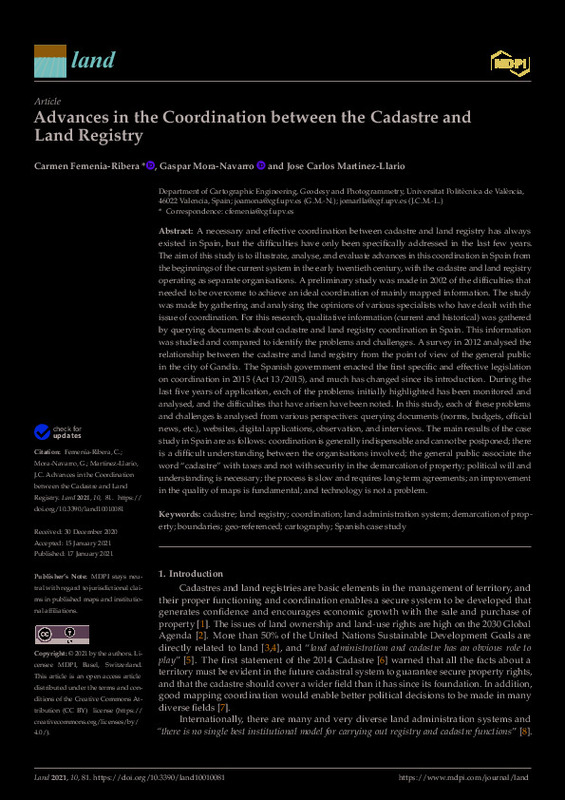|
Resumen:
|
[EN] A necessary and effective coordination between cadastre and land registry has always existed in Spain, but the difficulties have only been specifically addressed in the last few years. The aim of this study is to ...[+]
[EN] A necessary and effective coordination between cadastre and land registry has always existed in Spain, but the difficulties have only been specifically addressed in the last few years. The aim of this study is to illustrate, analyse, and evaluate advances in this coordination in Spain from the beginnings of the current system in the early twentieth century, with the cadastre and land registry operating as separate organisations. A preliminary study was made in 2002 of the difficulties that needed to be overcome to achieve an ideal coordination of mainly mapped information. The study was made by gathering and analysing the opinions of various specialists who have dealt with the issue of coordination. For this research, qualitative information (current and historical) was gathered by querying documents about cadastre and land registry coordination in Spain. This information was studied and compared to identify the problems and challenges. A survey in 2012 analysed the relationship between the cadastre and land registry from the point of view of the general public in the city of Gandia. The Spanish government enacted the first specific and effective legislation on coordination in 2015 (Act 13/2015), and much has changed since its introduction. During the last five years of application, each of the problems initially highlighted has been monitored and analysed, and the difficulties that have arisen have been noted. In this study, each of these problems and challenges is analysed from various perspectives: querying documents (norms, budgets, official news, etc.), websites, digital applications, observation, and interviews. The main results of the case study in Spain are as follows: coordination is generally indispensable and cannot be postponed; there is a difficult understanding between the organisations involved; the general public associate the word ¿cadastre¿ with taxes and not with security in the demarcation of property; political will and understanding is necessary; the process is slow and requires long-term agreements; an improvement in the quality of maps is fundamental; and technology is not a problem.
[-]
|
|
Código del Proyecto:
|
info:eu-repo/grantAgreement/MICINN//CSO2008-04808/ES/CREACION Y ALIMENTACION CARTOGRAFICA DE INFRAESTRUCTURAS DE DATOS ESPACIALES EN LA ADMINISTRACION LOCAL MEDIANTE UN MODELO DE DATOS QUE INTEGRE CATASTRO, PLANEAMIENTO Y PATRIMONIO HISTORICO/
info:eu-repo/grantAgreement/Ministerio de Ciencia e Innovación//DER2011-23321%2FJURI//El Registro de la Propiedad como instrumento vertebrador de la información territorial: datos espaciales, metadatos y directiva inspire/
info:eu-repo/grantAgreement/MINECO//DER2014-52262-P/ES/SITUACION ACTUAL Y PERSPECTIVAS DE FUTURO DE LA INFORMACION REGISTRAL: HACIA UN NUEVO MODELO DE ADMINISTRACION DEL TERRITORIO/
|
|
Agradecimientos:
|
For 2009-2012, this work was partially supported by research project entitled: `Creation and cartographic feeding of spatial data infrastructures in the local government by means of a data model that integrates cadastre, ...[+]
For 2009-2012, this work was partially supported by research project entitled: `Creation and cartographic feeding of spatial data infrastructures in the local government by means of a data model that integrates cadastre, planning and cultural heritage', CSO2008-04808. For the period 2013-2014, the work was partially supported by the research project: `The land registry as the basic tool for organising spatial information; INSPIRE Directive, spatial data and metadata', DER201123321/JURI. For 2015-2017, it was partially supported by research project `Current situation and future developments of land registry information: towards a new land administration model', DER2014-52262-P. All of projects were financed by the Spanish Government
[-]
|









